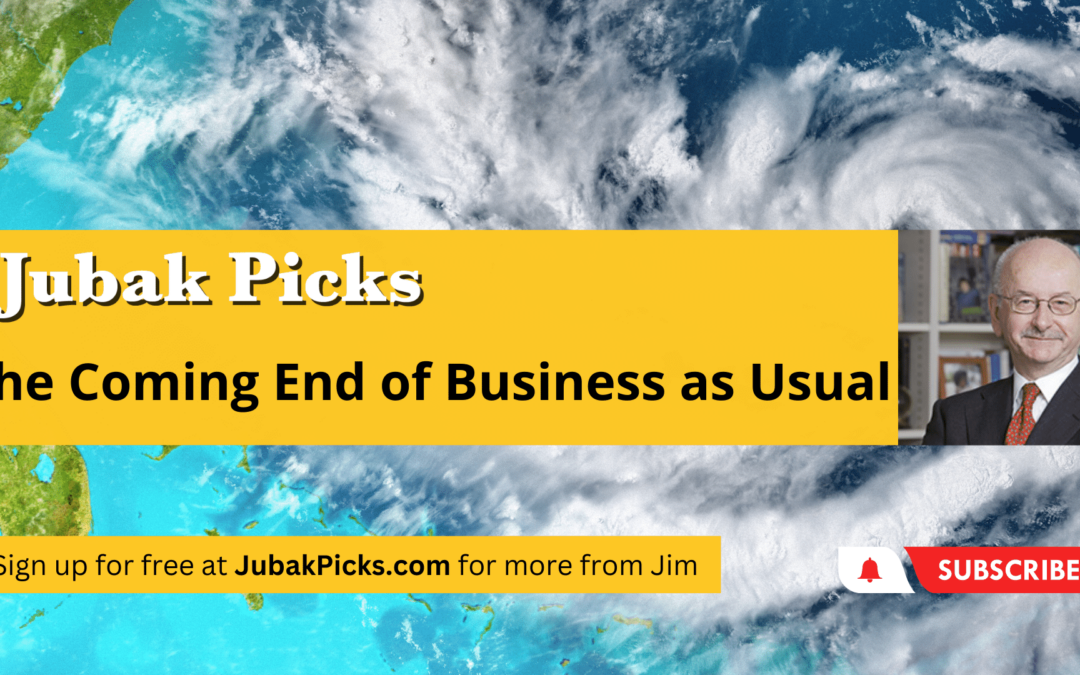
October 11, 2023 | Daily JAM, Dividend Income, Long Term, Morning Briefing, Volatility |
“Nobody expects the Spanish Inquisition!” Monty Python observed back in 1970 before attempting to torture a coal-miner’s wife with a dish rack. There’s an important investing version of this core truth: The financial market usually worries about the wrong problem. So that when the “Spanish Inquisition” (in financial terms) finally arrives, everybody is surprised. Well, we investors and traders have done it to ourselves again. We’ve spent much of 2022 and a good part of 2023 worrying about whether Federal Reserve interest rate increases would send the economy into a recession. There are still a few recession die hards worrying about that possibility, but by and large the worry has shifted to whether or not the Fed will delay its rate cuts in 2024–and thus delay the arrival of the “rate-cut-bounce.” While MANY–but certainly not all–investors, traders, and market analysts have been looking OVER THERE, however, the credit markets have built up a huge debt overhead and the global debt bomb looks ever closer to exploding. A crisis with the dire effects of the Global Financial Crisis of mid-2007 to 2009 is a possibility. I’d “guess” that most portfolios aren’t ready. The time to get ready is now. This increasingly looks like a debt market crisis of the type known as a Minsky Moment. To get ready first understand the source of the problem. I’m putting together a new Special Report for next week on what to do to get ready. Today’s post is a kind of set up, a get ready for the post on getting ready, if you will.

July 26, 2023 | Daily JAM, Videos |
Today’s video is The Coming End of Business as Usual. One of the most extraordinary things about the global climate catastrophe is how little effect it’s had on financial markets and their behavior and expectations. The markets still believe that The Fed and other world central banks are still in control of the global economy. Increasing that’s not so as thousands of people die from the heat, places become more and more unlivable, and entire industries face stunning systemic changes. An example of such change is the homeowners market in Louisiana, Florida and California. Louisiana, after dealing with increasingly damaging hurricanes in recent years, has had a dozen insurers go belly-up in the state. Now, about 100,000 households have been forced to move from private insurers into the insurance state fund. Just like Florida, this fiscally conservative state is moving more and more of its citizens to a state-run insurance pool. Sixteen storms and hurricanes in the past three years have resulted in $100-200 billion of property damage in Florida, causing insurance rates to go up 200% since 2019 and many insurers to cease doing business the state. Now 1.4 million people rely on Florida’s Citizens Property Plan, a state-run fund. The conservative state has to rely on–dare I say it, socialism–in order to keep its real estate market goin-it’s hard to get a mortgage to buy a house without homeowners insurance. In California, wildfires have caused homeowners insurance policies to go up 16%, with many insurers leaving the state. The state’s insurance plan called “FAIR” has seen enrollment double since 2019. These are examples of the ways in which capitalism and capital markets will change during this age of global catastrophe. I think we can expect more to come.

July 9, 2021 | Daily JAM, Morning Briefing |
Stocks rallied today and bond prices moved higher (sending bond yields lower) on news that China People’s Bank and the European Central Bank would both pursue monetary moves to bolster growth. The People’s bank reduced the amount of cash that banks have to hold in reserve by 0.5 percentage points. That will send about 1 trillion yuan ($154 billion) in liquidity into the economy. The reduction in the reserve ratio was larger than most economists had projected. China is set to announced second quarter GDP figures in the coming week and the strength and accelerated timing of the move fed speculation that the numbers will show weaker than expected economic growth. The European Central Bank shifted its inflation target to 2% rom the prior “below, but close to, 2%.” The move signaled that the ECB, like the U.S. Federal Reserve, would be willing to tolerate higher inflation in the short term rather than endanger economic growth by raising interest rates. The central banks move–plus a week of selling of cynical stocks, led to a solid rally today

February 6, 2020 | Daily JAM, GOLD, Stock Alerts |
Gold is supposed to go up when investors and traders are looking for safe havens and hedges against market volatility. So it makes sense the gold and gold mining stocks are gaining as coronavirus stalks through the land. Gold closed up 0.99% today to $1570.50 an...

January 29, 2020 | AG, Daily JAM, GLD, GOLD, Perfect Five-ETFs, Volatility |
Gold held by ETFs (exchange-traded funds) hit the highest level in seven years on Tuesday as investors and traders piled into the traditional hedge against uncertainty and stock market volatility. Worldwide gold holdings in ETFs rose to 2,561.2 tons as of Tuesday, the...

December 11, 2019 | Daily JAM |
Measures of volatility such as the VIX "fear index," the ratio of the implied volatility of S&P 500 put and call options, and the demand in the options market for protection against low-probability events, all say that investors and traders believe this is a...

December 8, 2019 | Daily JAM |
... central bank week. The Federal Reserve announces changes to U.S. benchmark interest rates on Wednesday, December 11. The central bank is expected to keep rates at current levels. The European Central Bank meets a day later, on Thursday, December 12. It too is...

September 9, 2019 | Daily JAM |
Will the European Central Bank revive its program of bond-buying when it meets on Thursday? The bank only ended this program of quantitative easing in December. The markets are currently pricing in a new program of 40 billion euros a month in bond purchases--plus a...

August 25, 2019 | Daily JAM |
... financial markets to ignore very clear warnings from global central banks at the Federal Reserve's Jackson Hole conference this weekend. Central bankers, including the Fed's Jerome Powell, were very clear in warning that central bank monetary policy tools were not...

August 19, 2019 | Daily JAM, Morning Briefing |
Gotta love that financial market enthusiasm for central banks. Last week the markets rallied on signals from the European Central Bank that it would cut its key interest rate--now at a negative 0.40%--to a negative -0.50%, lower the rates that banks pay to borrow...

April 8, 2019 | Daily JAM, Mid Term |
Something happened at the end of March that we all need to pay attention to. By this point in the aftermath of the global financial crisis, we're immune to wonder at the existence of government bonds with negative yields. Why would anyone in their right minds pay a...

February 16, 2018 | Daily JAM, Long Term, Volatility |
Before this market rout and from the safety of the World Economic Forum in Davos, hedge fund legend Ray Dalio talked about the coming bear market in bonds and likelihood that we were near the end of this cycle of economic boom. Sometime in the next two years, he remarked, we were likely to experience a recession and that would put an end to one of the longest periods of economic growth in the United States. With the experience of the big market rout of January 26 through February 8 behind us–if it indeed is–when the Standard & Poor 500 stock index fell 9.03%, I’d like to make Dalio’s comments a little more explicit and apply them more directly to the stock market.











